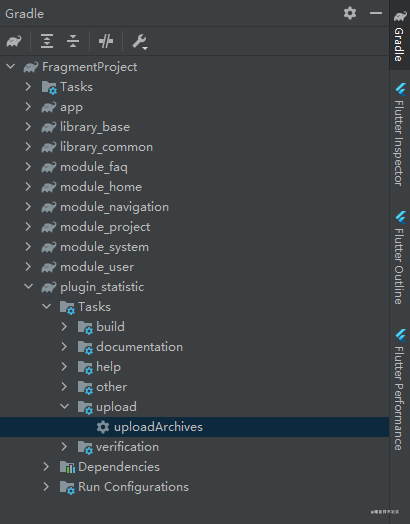input.jarInputs.each { JarInput jarInput ->
handleJarInput(jarInput, outputProvider)
}
}
}
/**
- 处理文件目录下的class文件
*/
static void handleDirectoryInput(DirectoryInput directoryInput, TransformOutputProvider outputProvider) {
//是否是目录
if (directoryInput.file.isDirectory()) {
//列出目录所有文件(包含子文件夹,子文件夹内文件)
directoryInput.file.eachFileRecurse { File file ->
def name = file.name
if (filterClass(name)) {
ClassReader classReader = new ClassReader(file.bytes)
ClassWriter classWriter = new ClassWriter(classReader, ClassWriter.COMPUTE_MAXS)
ClassVisitor classVisitor = new BuryPointVisitor(classWriter)
classReader.accept(classVisitor, ClassReader.EXPAND_FRAMES)
byte[] code = classWriter.toByteArray()
FileOutputStream fos = new FileOutputStream(file.parentFile.absolutePath + File.separator + name)
fos.write(code)
fos.close()
}
}
}
//文件夹里面包含的是我们手写的类以及R.class、BuildConfig.class以及R$XXX.class等
// 获取output目录
def dest = outputProvider.getContentLocation(
directoryInput.name,
directoryInput.contentTypes,
directoryInput.scopes,
Format.DIRECTORY)
//这里执行字节码的注入,不操作字节码的话也要将输入路径拷贝到输出路径
FileUtils.copyDirectory(directoryInput.file, dest)
}
/**
- 处理jar文件,一般是第三方依赖库jar文件
*/
static void handleJarInput(JarInput jarInput, TransformOutputProvider outputProvider) {
if (jarInput.file.getAbsolutePath().endsWith(“.jar”)) {
//重名名输出文件,因为可能同名,会覆盖
def jarName = jarInput.name
def md5Name = DigestUtils.md5Hex(jarInput.file.getAbsolutePath())
if (jarName.endsWith(“.jar”)) {
jarName = jarName.substring(0, jarName.length() - 4)
}
JarFile jarFile = new JarFile(jarInput.file)
Enumeration enumeration = jarFile.entries()
File tmpFile = new File(jarInput.file.getParent() + File.separator + “temp.jar”)
//避免上次的缓存被重复插入
if (tmpFile.exists()) {
tmpFile.delete()
}
JarOutputStream jarOutputStream = new JarOutputStream(new FileOutputStream(tmpFile))
//用于保存
while (enumeration.hasMoreElements()) {
JarEntry jarEntry = (JarEntry) enumeration.nextElement()
String entryName = jarEntry.getName()
ZipEntry zipEntry = new ZipEntry(entryName)
InputStream inputStream = jarFile.getInputStream(jarEntry)
//插桩class
if (filterClass(entryName)) {
//class文件处理
jarOutputStream.putNextEntry(zipEntry)
ClassReader classReader = new ClassReader(IOUtils.toByteArray(inputStream))
ClassWriter classWriter = new ClassWriter(classReader, ClassWriter.COMPUTE_MAXS)
ClassVisitor classVisitor = new BuryPointVisitor(classWriter)
classReader.accept(classVisitor, ClassReader.EXPAND_FRAMES)
byte[] bytes = classWriter.toByteArray()
jarOutputStream.write(bytes)
} else {
jarOutputStream.putNextEntry(zipEntry)
jarOutputStream.write(IOUtils.toByteArray(inputStream))
}
jarOutputStream.closeEntry()
}
//结束
jarOutputStream.close()
jarFile.close()
//生成输出路径 + md5Name
def dest = outputProvider.getContentLocation(
jarName + md5Name,
jarInput.contentTypes,
jarInput.scopes,
Format.JAR)
FileUtils.copyFile(tmpFile, dest)
tmpFile.delete()
}
}
/**
-
检查class文件是否需要处理
-
@param fileName
-
@return
*/
static boolean filterClass(String name) {
return (name.endsWith(“.class”)
&& !name.startsWith(“R$”)
&& “R.class” != name
&& “BuildConfig.class” != name)
}
}
3、BuryPointVisitor
通过visitMethod拿到方法进行修改
class BuryPointVisitor extends ClassVisitor {
…省略中间非关键代码,详细请到github中查看…
/**
-
扫描类的方法进行调用
-
@param access 修饰符
-
@param name 方法名字
-
@param descriptor 方法签名
-
@param signature 泛型信息
-
@param exceptions 抛出的异常
-
@return
*/
@Override
MethodVisitor visitMethod(int methodAccess, String methodName, String methodDescriptor, String signature, String[] exceptions) {
MethodVisitor methodVisitor = super.visitMethod(methodAccess, methodName, methodDescriptor, signature, exceptions)
return new BuryPointMethodVisitor(methodVisitor, methodAccess, methodName, methodDescriptor)
}
}
4、BuryPointMethodVisitor
终于到了本次文章的核心代码了。
visitAnnotation在扫描到注解时调用。我们通过 descriptor 来判断是否是需要埋点的注解,如果是则保存注解参数和对应的方法名称,等到onMethodEnter时进行代码插入。
visitInvokeDynamicInsn在描到lambda表达式时调用,bootstrapMethodArguments[0] 得到方法描述,通过 name + desc 判断当前lambda表达式是否是需要的埋点的方法,如果是则保存lambda方法名称,等到onMethodEnter时进行代码插入。
onMethodEnter在进入方法时调用,这里就是我们插入代码的地方了。通过 methodName + methodDescriptor 判断当前方法是否是需要的埋点的方法,如果是则插入埋点方法。
######——重点,要考,画起来——
mv.visitVarInsn(store, i + methodArgumentSize + 1)为什么要 +methodArgumentSize 呢?
答:简单的说就是我们通过visitLdcInsn把注解参数压入到局部变量表中,而局部变量表(Local Variable Table)是一组变量值存储空间,用于存放 方法参数和方法内定义的局部变量,所以在取值的时候要方法参数的数量。 2.int slotIndex = isStatic(methodAccess) ? 0 : 1 为什么 static 方法是0开始计算? 答:普通方法的局部变量表第一个参数是this(当前对象的引用)所以要加1。
class BuryPointMethodVisitor extends AdviceAdapter {
int methodAccess
String methodName
String methodDescriptor
BuryPointMethodVisitor(MethodVisitor methodVisitor, int access, String name, String desc) {
super(Opcodes.ASM7, methodVisitor, access, name, desc)
this.methodAccess = access
this.methodName = name
this.methodDescriptor = desc
}
/**
-
扫描类的注解时调用
-
@param descriptor 注解名称
-
@param visible
-
@return
*/
@Override
AnnotationVisitor visitAnnotation(String descriptor, boolean visible) {
AnnotationVisitor annotationVisitor = super.visitAnnotation(descriptor, visible)
// 通过descriptor判断是否是需要扫描的注解
BuryPointCell cell = StatisticPlugin.HOOKS.get(descriptor)
if (cell != null) {
BuryPointCell newCell = cell.clone()
return new BuryPointAnnotationVisitor(annotationVisitor) {
@Override
void visit(String name, Object value) {
super.visit(name, value)
// 保存注解的参数值
newCell.annotationData.put(name, value)
}
@Override
void visitEnd() {
super.visitEnd()
newCell.methodName = methodName
newCell.methodDesc = methodDescriptor
StatisticPlugin.HOOKS.put(newCell.methodName + newCell.methodDesc, newCell)
}
}
}
return annotationVisitor
}
/**
-
lambda表达式时调用
-
@param name
-
@param descriptor
-
@param bootstrapMethodHandle
-
@param bootstrapMethodArguments
*/
@Override
void visitInvokeDynamicInsn(String name, String descriptor, Handle bootstrapMethodHandle, Object… bootstrapMethodArguments) {
super.visitInvokeDynamicInsn(name, descriptor, bootstrapMethodHandle, bootstrapMethodArguments)
String desc = (String) bootstrapMethodArguments[0]
BuryPointCell cell = StatisticPlugin.HOOKS.get(name + desc)
if (cell != null) {
String parent = Type.getReturnType(descriptor).getDescriptor()
if (parent == cell.methodParent) {
Handle handle = (Handle) bootstrapMethodArguments[1]
BuryPointCell newCell = cell.clone()
newCell.isLambda = true
newCell.methodName = handle.getName()
newCell.methodDesc = handle.getDesc()
StatisticPlugin.HOOKS.put(newCell.methodName + newCell.methodDesc, newCell)
}
}
}
/**
- 方法进入时调用
*/
@Override
protected void onMethodEnter() {
super.onMethodEnter()
BuryPointCell buryPointCell = StatisticPlugin.HOOKS.get(methodName + methodDescriptor)
if (buryPointCell != null && !buryPointCell.isMethodExit) {
onMethod(buryPointCell)
}
}
/**
- 方法退出前调用
*/
@Override
protected void onMethodExit(int opcode) {
BuryPointCell buryPointCell = StatisticPlugin.HOOKS.get(methodName + methodDescriptor)
if (buryPointCell != null && buryPointCell.isMethodExit) {
onMethod(buryPointCell)
}
super.onMethodExit(opcode)
}
private void onMethod(BuryPointCell cell) {
// 获取方法参数
Type methodType = Type.getMethodType(methodDescriptor)
Type[] methodArguments = methodType.getArgumentTypes()
int methodArgumentSize = methodArguments.size()
if (cell.isAnnotation) { // 遍历注解参数并赋值给采集方法
def entrySet = cell.annotationParams.entrySet()
def size = entrySet.size()
for (int i = 0; i < size; i++) {
def key = entrySet[i].getKey()
if (key == “this”) {
mv.visitVarInsn(Opcodes.ALOAD, 0)
} else {
def load = entrySet[i].getValue()
def store = getVarInsn(load)
mv.visitLdcInsn(cell.annotationData.get(key))
mv.visitVarInsn(store, i + methodArgumentSize + 1)
mv.visitVarInsn(load, i + methodArgumentSize + 1)
}
}
mv.visitMethodInsn(INVOKESTATIC, cell.agentParent, cell.agentName, cell.agentDesc, false)
// 防止其他类重名方法被插入
StatisticPlugin.HOOKS.remove(methodName + methodDescriptor, cell)
} else { // 将扫描方法参数赋值给采集方法
// 采集数据的方法参数起始索引( 0:this,1+:普通参数 ),如果是static,则从0开始计算
int slotIndex = isStatic(methodAccess) ? 0 : 1
// 获取采集方法参数
Type agentMethodType = Type.getMethodType(cell.agentDesc)
Type[] agentArguments = agentMethodType.getArgumentTypes()
List agentArgumentList = new ArrayList(Arrays.asList(agentArguments))
// 遍历方法参数
for (Type argument : methodArguments) {
int size = argument.getSize()
int opcode = argument.getOpcode(ILOAD)
String descriptor = argument.getDescriptor()
Iterator agentIterator = agentArgumentList.iterator()
// 遍历采集方法参数
while (agentIterator.hasNext()) {
Type agentArgument = agentIterator.next()
String agentDescriptor = agentArgument.getDescriptor()
if (agentDescriptor == descriptor) {
mv.visitVarInsn(opcode, slotIndex)
agentIterator.remove()
break
}
}
slotIndex += size
}
if (agentArgumentList.size() > 0) { // 无法满足采集方法参数则return
return
}
mv.visitMethodInsn(INVOKESTATIC, cell.agentParent, cell.agentName, cell.agentDesc, false)
if(cell.isLambda){
StatisticPlugin.HOOKS.remove(methodName + methodDescriptor, cell)
}
}
}
/**
-
推断类型
-
int ILOAD = 21; int ISTORE = 54;
-
33 = ISTORE - ILOAD
-
@param load
-
@returno
*/
private static int getVarInsn(int load) {
return load + 33
}
private static boolean isStatic(int access) {
return (access & Opcodes.ACC_STATIC) != 0
}
}
5、 如何使用?
5.1、 先打包插件到本地仓库进行引用

5.2、 在项目的根build.gradle加入插件的依赖
repositories {
google()
mavenCentral()
jcenter()
maven{
url uri(‘repos’)
}
}
dependencies {
classpath “com.android.tools.build:gradle:$gradle_version”
classpath “org.jetbrains.kotlin:kotlin-gradle-plugin:$kotlin_version”
classpath ‘com.meituan.android.walle:plugin:1.1.7’
// 使用自定义插件
classpath ‘com.example.plugin:statistic:1.0.0’
// NOTE: Do not place your application dependencies here; they belong
// in the individual module build.gradle files
}
5.3、 在app的build.gradle中使用并配置参数
plugins {
id ‘com.android.application’
id ‘statistic’
}
buryPoint {
hooks = [
[
‘agentName’ : ‘viewOnClick’, //采集数据的方法名
‘agentDesc’ : ‘(Landroid/view/View;)V’, //采集数据的方法描述(参数应在methodDesc范围之内)
‘agentParent’ : ‘com/example/fragment/project/utils/StatisticHelper’, //采集数据的方法的路径
‘isAnnotation’: false,
‘methodName’ : ‘onClick’, //插入的方法名
最后,如果大伙有什么好的学习方法或建议欢迎大家在评论中积极留言哈,希望大家能够共同学习、共同努力、共同进步。
小编在这里祝小伙伴们在未来的日子里都可以 升职加薪,当上总经理,出任CEO,迎娶白富美,走上人生巅峰!!
不论遇到什么困难,都不应该成为我们放弃的理由!
很多人在刚接触这个行业的时候或者是在遇到瓶颈期的时候,总会遇到一些问题,比如学了一段时间感觉没有方向感,不知道该从那里入手去学习
如果你看到了这里,觉得文章写得不错就给个赞呗?如果你觉得那里值得改进的,请给我留言,一定会认真查询,修正不足,谢谢。
《Android学习笔记总结+移动架构视频+大厂面试真题+项目实战源码》,点击传送门,即可获取!






















 802
802











 被折叠的 条评论
为什么被折叠?
被折叠的 条评论
为什么被折叠?








